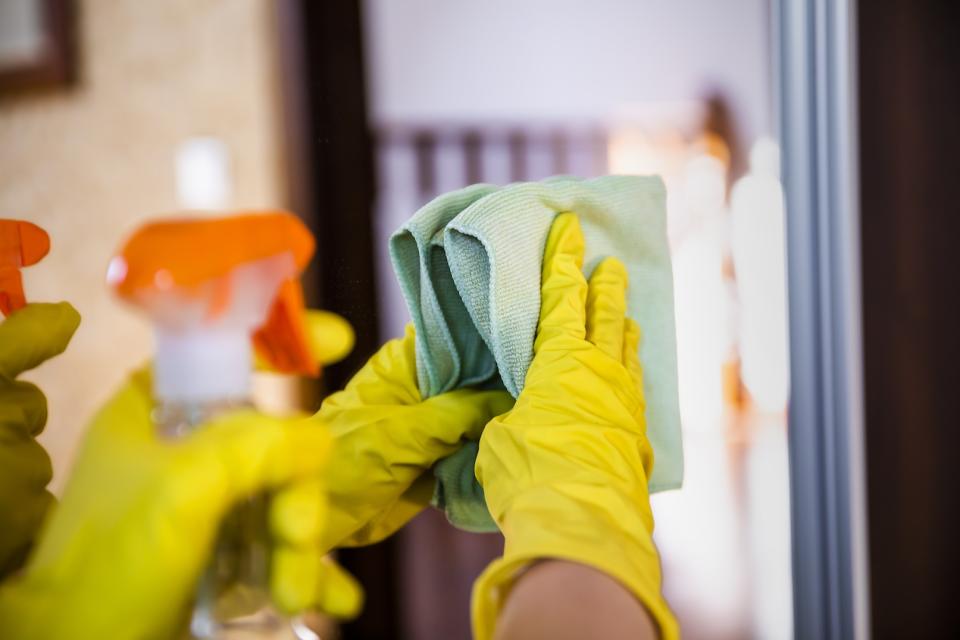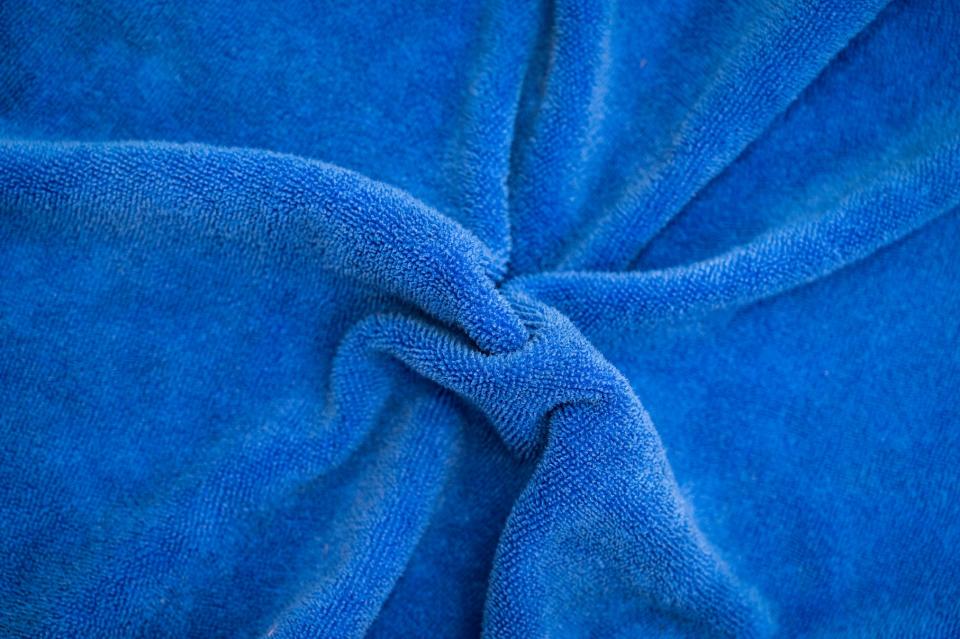How to Clean a Mirror Without Windex: Cleaning Pros Are Moving Away From Ammonia-Based Sprays — Here's Why
Sure, your mirror probably isn’t the grimiest spot in the bathroom. But streaks, fingerprints, water spots, and toothpaste splatter can all come between you and a clear reflection — so your mirror still needs to be cleaned regularly.
Windex may seem like the obvious choice to get the job done, but ammonia-based glass cleaners may not actually be the most effective option, and they could even pose some potential health risks. So, you might be wondering how to make your mirrors sparkle without harsh cleaners. We asked the experts how to clean a mirror without Windex — here’s what you need to know.
Is Windex toxic?
One of the cleaning agents in Windex is ammonium hydroxide, also known as household ammonia. Ammonia is a strong solvent with the ability to break down oils and soap scum, and it evaporates quickly, which helps to minimize streaks.
But ammonia isn’t only harsh on grease and grime — according to the CDC, its corrosive properties may also irritate your skin, eyes, throat, and lungs. While glass cleaners like Windex contain diluted ammonia, you may still experience irritation, especially if you tend to be sensitive to chemicals.
“While ammonia-based cleaners can be effective at cutting through grease and leaving mirrors streak-free, they can also be harsh on the environment and potentially irritating for those with respiratory issues or sensitivities,” says Ronnie Kendrick, founder of CompanyClean, a residential cleaning service in Highlands Ranch, Colorado.
Also important: Ammonia-based cleaners should never be mixed with bleach products. When ammonia and bleach combine, they form toxic chlorine gas. Inhaling this gas can be dangerous — or even deadly.
Why cleaning pros are moving away from Windex
Cleaning experts say you can skip the harsh cleaners without sacrificing the sparkle. Windex and other ammonia-based cleaners are “not our go-to,” Kendrick says.
Ammonia also has the potential to damage nearby surfaces such as stainless steel fixtures, wood mirror frames, or granite countertops, so you’ll need to be careful about overspray when using it.
Bottom line: While ammonia-based glass cleaners get the job done, they’re not always the ideal choice for your health, your bathroom, or the planet. Some of the kinder, gentler alternatives can clean mirrors just as well — or even better — so it’s worth exploring your options.
How to clean a mirror without Windex

1. Use water for easy cleanups
When you just need to wipe off everyday dust and smudges, plain old water can do the trick. “If it's a quick clean, I just use a fine-woven microfiber cloth and a spray bottle of water,” says cleaning expert Leslie Reichert, a.k.a. The Cleaning Coach, author of The Joy of Green Cleaning. “It works great and is so simple.”
2. Try ammonia-free cleaners
“We've found that there are several non-ammonia-based products that are just as effective without the potential drawbacks,” Kendrick says. “Personally, I swear by Sprayway Foaming Glass Cleaner (buy on Amazon, $7.89) for my mirrors. It's efficient, leaves no streaks, and is cost-effective. We've also been utilizing a glass cleaner from Ecologic Solutions (buy at Universal Solutions, $8.95) which has proven effective.”
3. Mix up a DIY glass cleaning spray
Reichert cleans her mirrors with a homemade mixture of distilled water, rubbing alcohol, and distilled white vinegar. Using distilled water will help you avoid getting mineral deposits on your mirror, especially if you have hard water, she explains. If you’re out of rubbing alcohol, Reichert recommends a surprising substitute — vodka! (Click through to 13 Brilliant Uses For White Vinegar Guaranteed To Make Your Life Easier.)
4. Brew some tea or coffee
Some professional cleaners swear by black tea or coffee as a mirror-cleaning hack, Kendrick says: “The tannic acid helps break down dirt and can leave a shine. Just ensure you finish with a dry microfiber cloth to prevent streaks — and don't drink it afterward.”
How to clean a mirror without streaks
If you’ve ever been stuck with streaks after cleaning your mirror, you know there’s a certain finesse to getting a crystal-clear reflection. So what’s the secret to a streak-free shine?
First, make sure you’re using the right cloth for the job. Paper towels can leave lint on your mirror — plus they’re a disposable product, so they’re not the best pick from a sustainability standpoint. Instead, opt for a microfiber cloth. “They’re designed to trap dirt and reduce streaks, and they're lint-free,” Kendrick says.

Along with choosing the right type of cloth, it’s important to make sure your cloths are clean and dry. “Make sure you're changing or rinsing the cloth frequently enough,” Kendrick says. “If you're not, that can spread dirt and grime, causing more harm than good.”
Stock up on microfiber cleaning cloths at wholesale stores like Costco and Sam’s Club, or on Amazon. “It's better to have too many cloths than too few,” Kendrick adds. “Always have a cloth you're using for cleaning, then a separate one for drying and buffing. This simple tip can revolutionize your cleaning.”
Residue from stains and smudges can also cause streaks as you wipe, so be sure to spot-clean any fingerprints, water spots, or toothpaste first to avoid spreading them across the mirror. Also, avoid wiping in circles, which can lead to streaking. “We recommend using a side-to-side or up-and-down motion when cleaning mirrors,” Kendrick says. “This technique tends to reduce streaks and ensures a more even clean across the surface.”
Last but not least, any leftover cleaner can leave streaks, so make sure to wipe your mirror until every bit of product is gone and the glass is perfectly dry. You’ll know it’s fully dry when you can feel the “drag” of wiping a dry cloth over a dry mirror, Reichert says.
How to clean a mirror that’s hazy
Weirdly enough, if your mirror keeps clouding up, it might be a sign that you’re using too much cleaner. A build-up of cleaning products can leave residue on your mirror, Kendrick cautions, so be sparing with your spray bottle. “I'd recommend starting with just a light mist or a couple of spritzes on either the microfiber cloth or the mirror itself,” he says. “You're not trying to create a rain curtain here. It's easier to add more if needed than to deal with excess product.”
Letting cleaner dry on the mirror can also cause haziness, so if you’re cleaning a large mirror, Kendrick suggests tackling it in sections. Lightly spray a small section at the top, then wipe it completely dry before moving on to the next section.
Vinegar can also cut through haze on a mirror, so this is the perfect opportunity to test out Reichert’s DIY cleaner. Wipe your mirror down with a microfiber mop and a small amount of cleaner, then follow it up with a dry microfiber cloth or a squeegee until it’s completely dry.
For more cleaning tricks, click through:
Cleaning Pictures: How To Make Your Framed Photos Look Their Best, According to an Art Pro
Dodge the Side Effects of Commercial Cleaners with These DIY Cleaning Product Recipes
First For Women aims to feature only the best products and services. We update when possible, but deals expire and prices can change. If you buy something via one of our links, we may earn a commission.
Questions? Reach us at shop@firstforwomen.com

